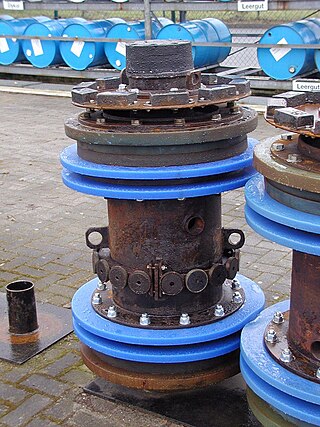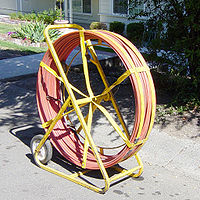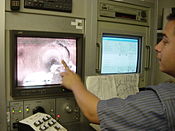
Plumbing is any system that conveys fluids for a wide range of applications. Plumbing uses pipes, valves, plumbing fixtures, tanks, and other apparatuses to convey fluids. Heating and cooling (HVAC), waste removal, and potable water delivery are among the most common uses for plumbing, but it is not limited to these applications. The word derives from the Latin for lead, plumbum, as the first effective pipes used in the Roman era were lead pipes.

A pipeline is a system of pipes for long-distance transportation of a liquid or gas, typically to a market area for consumption. The latest data from 2014 gives a total of slightly less than 2,175,000 miles (3,500,000 km) of pipeline in 120 countries around the world. The United States had 65%, Russia had 8%, and Canada had 3%, thus 76% of all pipeline were in these three countries. The main attribute to pollution from pipelines is caused by corrosion and leakage

A sanitary sewer is an underground pipe or tunnel system for transporting sewage from houses and commercial buildings to a sewage treatment plant or disposal.
A drain cleaner or opener is a person, device or product unblocking sewer pipes or clogged wastewater drains. The term usually refers to a chemical or mechanical utensil such as a commercial chemical product, plumber's snake, drain auger or toilet plunger. Occasionally, it is applied to a plumber or another individual who performs the drain cleaning and hygiene.

Roto-Rooter Plumbing & Water Cleanup is a Cincinnati, Ohio based plumbing company. The company, founded in 1935, originally specialized in clearing tree roots and other obstructions from sewer lines.

In pipeline transportation, pigging is the practice of using pipeline inspection gauges or gadgets, devices generally referred to as pigs or scrapers, to perform various maintenance operations. This is done without stopping the flow of the product in the pipeline.

A utility tunnel, utility corridor, or utilidor is a passage built underground or above ground to carry utility lines such as electricity, steam, water supply pipes, and sewer pipes. Communications utilities like fiber optics, cable television, and telephone cables are also sometimes carried. One may also be referred to as a services tunnel, services trench, services vault, or cable vault. Smaller cable containment is often referred to as a cable duct or underground conduit. Direct-buried cable is a major alternative to ducts or tunnels.
Pipe bursting is a trenchless method of replacing buried pipelines without the need for a traditional construction trench. "Launching and receiving pits" replace the trench needed by conventional pipe-laying.
Directional boring, also referred to as horizontal directional drilling (HDD), is a minimal impact trenchless method of installing underground utilities such as pipe, conduit, or cables in a relatively shallow arc or radius along a prescribed underground path using a surface-launched drilling rig. Directional boring offers significant environmental advantages over traditional cut and cover pipeline/utility installations. The technique is routinely used when conventional trenching or excavating is not practical or when minimal surface disturbance is required.

A cured-in-place pipe (CIPP) is a trenchless rehabilitation method used to repair existing pipelines. It is a jointless, seamless pipe lining within an existing pipe. As one of the most widely used rehabilitation methods, CIPP has applications in sewer, water, gas, chemical and district heating pipelines ranging in diameter from 0.1 to 2.8 meters.

The MineCam is a remote exploration camera built by I.A.Recordings. It is used for mine shaft exploration and other similar environments. It was originally conceptualized in 1988, and since went under several design revisions. The name MineCam, is a pun on MiniCam, an early hand-held broadcast camera built by CBS Laboratories.
Sliplining is a technique for repairing leaks or restoring structural stability to an existing pipeline. It involves installing a smaller, "carrier pipe" into a larger "host pipe", grouting the annular space between the two pipes, and sealing the ends. Sliplining has been used since the 1940s.
A suction excavator or vacuum excavator is a construction vehicle that removes heavy debris or other materials from a hole on land.

The US natural gas pipeline system is a complex system of pipelines that carries natural gas nationwide and for import and export for use by millions of people daily for their consumer and commercial needs. Across the country, there are more than 210 pipeline systems that total more than 305,000 miles of interstate and intrastate pipelines.
Robotic non-destructive testing (NDT) is a method of inspection used to assess the structural integrity of petroleum, natural gas, and water installations. Crawler-based robotic tools are commonly used for in-line inspection (ILI) applications in pipelines that cannot be inspected using traditional intelligent pigging tools.
Electro Scan Inc. is a designer and manufacturer of water and sewer machine-intelligent pipeline inspection devices and provider of Software-as-a-Service (SaaS) based cloud reporting. The company utilizes electric currents to detect leaks in non-conductive sewer pipes. The company is based in Sacramento, California, with additional offices in London, England and Toronto, Canada.
CISBOT is a cast iron pipe-repair robot that seals the joints in natural gas pipelines from the inside, thus extending their use for up to fifty years without unearthing the joints.
CCTV drain cameras, also known as sewer cameras or pipe inspection cameras, are a line of waterproof, high definition cameras that have become a widely popular technology in the plumbing profession. These cameras are advanced diagnostic tools that allow plumbers to execute plumbing inspections with heightened accuracy.

A sanitary manhole is a manhole that is used as an access point for maintenance and inspection of an underground sanitary sewer system. Sanitary manholes are sometimes used as vents to prevent the buildup of pressurized sewage gas. Additionally, they are used for debris removal, and application of chemicals such as degreaser and insecticide.



















